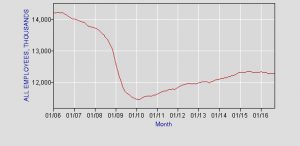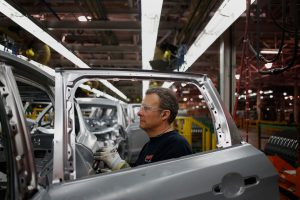 Throughout Donald Trump’s presidential campaign, he has carried out the consistent theme of the United States losing at trade, and using the trade deficit as the evidence.
Throughout Donald Trump’s presidential campaign, he has carried out the consistent theme of the United States losing at trade, and using the trade deficit as the evidence.
“We’re losing a tremendous amount of money, according to many stats, $800 billion a year on trade,” he told The Times.
“They’re(China and Mexico)beating us so badly,” he has said. “Every country we lose money with.”
Americans are drawn to this rhetoric, because they’re dissatisfied and fearful, particularly those in the unemployed and underemployed working class.
However, Trump’s framing of the trade deficit even conflicts with the view of many economists like Robert E. Scott, Senior Economist and Director of Trade and Manufacturing Policy Research for the Economic Policy Institute, who agree that the current trade agreements are detrimental to American workers and want to see change. The best and most widespread view among economists conclude that, trade deficits are not inherently good or bad; they can be either, depending on circumstances.
Trump uses his anti-China sentiments as a rhetorical strategy to convince Americans that eliminating the trade deficit would make America great again. But, trying to eliminate the trade deficit could mean giving up some of the key levers of power that allow the United States to get its way in international politics. Thus, struggling Americans must rethink the Trumponomics that quickly blames trade agreements with China for our economic concerns.
Yesterday’s Problem

Despite the rhetoric of Trump, global manufacturing is trending in a positive direction for the U.S. According to the Bureau of Labour Statistics, factory jobs are on the rise in the U.S. and many of these new jobs are coming back to North America from China, which is struggling to maintain its manufacturing capacity. In a 2015 study, the Boston Consulting Group said the costs of manufacturing in China’s major export-producing zone were now almost the same as in the United States, after taking into account wages, worker productivity, energy costs and other factors. Meaning, that China may not be as big of a problem as this years candidates have made it seem.
A Turning Tide

Once again, however, predictions of the collapse of American manufacturing are slowly being proved wrong. Although, China dominated the manufacturing industry between the years of 1999-2011, jobs are gradually finding their way back to the United States. Trump has successfully used his rhetoric to inspire and motivate many struggling Americans that have lost their manufacturing jobs — but while doing so he has motivated the worst in people, not the best. He appeals to their negative emotions about their current situation as rhetorical strategy to gain their support of Trumponomics. However, as the election rapidly approaches voters must seriously analyze if his plans are actually reasonable.

I see how there is a question with China and the issues around our trade agreements. In other articles I have read the same thing, that economist suggest Trump’s plan’s could devastate the economy. But if anything Trump is using this in his campaign to gain more voters. This is just speculation but, whether or not it is a real issue – if his campaign drives the point home that he can help with China treating us “so badly” people will follow.